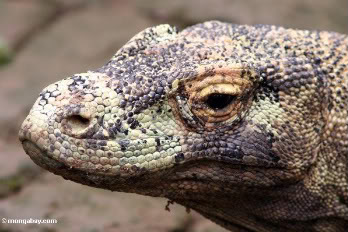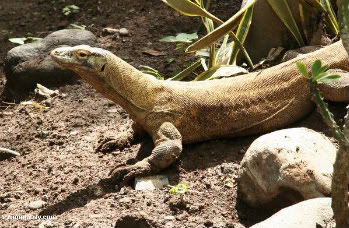A row has taken off in Indonesia over whether or not to allow gold mining near Komodo National Park, home to the infamous, venomous, and largest of all lizards, the Komodo dragon. Eight mines have currently been proposed, several have already begun exploratory work. Critics of the gold mines contend that the mining threatens the ecology of the park and the Komodo dragon, listed as Vulnerable by the IUCN.
“Komodo dragons live here (and only here) and the national park together with the dragons, coral and fish are integral for what little tourism they get here. The entire community in the state relies on income generated either directly or indirectly from this area,” a local source said. “The locals here don’t want the mine but are powerless to stop it. They have attempted a blockade but to no avail.”
 The Komodo dragon is endemic to a small number of Indonesian islands. Photo by: Rhett A. Butler. |
The local government and members of the national government have argued that the mine is far enough away not to impact the park.
“I’ve visited the site of the mining company,” Forestry Minister M.S. Kaban told the Jakarta Post. “It’s about 20 kilometers from the Komodo National Park, so it won’t damage the park’s ecosystem.”
The head of Komodo National Park, Tamen Sitorus, appears to agree. He was quoted as saying that the mining was far enough away that it “won’t do any harm to the national park yet.” He added, however, that if the mines move beyond the exploratory stage then he will be concerned for the islands’ marine environment, which locals depend on.
“All sediment and waste products are to be washed into the ocean into the current through the national park,” Mongabay’s local source said. “Also food supply will decrease with the oceans being contaminated with soil and wastes.”
One of the mining sites has already come under investigation for allegedly violating environmental regulations. Officials visited the Chinese-backed exploratory mine on Batugosok Island saying that the digging began before the approval of an environmental assessment, which if true, would violate China’s new environmental guidelines for companies operating overseas.
The findings spurred Indonesia’s Environment Minister, Rachmat Witoelar, to say that the mine should be shut-down. “I still need to look more into the report, but we would want it to be closed down,” he said.
 The Komodo dragon preys on a wide variety of species, including deer, boar, water buffalo, horses, goat, monkeys, birds and birds’ eggs, and even smaller Komodo dragons. Attacks on humans by Komodo dragons is very rare, but it has happened. Photo by: Rhett A. Butler. |
The regional environmental minister, Sudirman, concurred, stating that the mine had damaged the area’s topography and tourism. He added the company did not have the documents required pertaining to environmental management and monitoring. “Batugosok Island was intended for tourism and not mining,” he told the press.
Many believe that regardless of ecological cost the mines will damage tourism.
“The Komodo National Park is a national and international icon. It brings the government an annual revenue of Rp 70 billion [US$7 million]. Mining activities near the park will only ruin the park’s image and diminish the government’s revenue,” Dambung Lamuara Djaja, a tourism consultant said.
Eighty percent of gold mined in the world is used to make jewelry and much of the mining is done in ecological sensitive areas, such as rainforests.
Although it’s the headliner, the Komodo dragon is not the only endangered inhabitant of Komodo National Park. Its main source of prey the Timor deer Cervus timorensis is listed as Vulnerable by the IUCN as well. In addition, nearly 70 percent of the park is marine environment.
Created in 1980 over several islands, the park contains half of the world’s Komodo dragons: 2,500 individuals.
Related articles
Photo: Scientists discover new species of Komodo dragon-like lizard
(07/21/2009) German researchers have discovered a new species of monitor lizard in Indonesia using DNA analysis and morphological characteristics. The species, Varanus lirungensis, is described in the Australian Journal of Zoology.
(05/18/2009) The world’s largest lizard relies on venom to weaken and immobilize its prey report researchers writing in Proceedings of the National Academy of Sciences. Until now it was believed that bacteria resident in the Komodo Dragon’s mouth were the source of the reptile’s toxicity.
Fisherman killed by two Komodo dragons
(03/24/2009) Mohamad Anwar, 32, was killed by two Komodo dragons after trespassing in Komodo National Park in order to gather fruit according to CNN.














